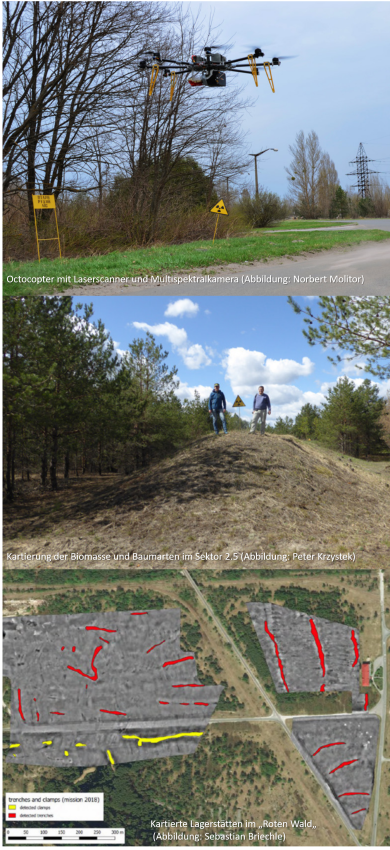Mapping of disasters and risk areas
Detection of radioactive legacy sites in the Chernobyl exclusion zone by means of drone-based laser scanning
Background
On April 26, 1986, the most severe nuclear accident to date occurred at the Chernobyl nuclear power plant. The heavy contamination led to complete evacuation in an area with a radius of about 30 kilometers. The pine forest around the power plant, which turned reddish due to the strong radioactive radiation and therefore went down in history as the "Red Forest", became sadly famous.
In particularly heavily contaminated areas, the contaminated biomass and topsoil were buried to reduce the radioactive contamination by orders of magnitude. Since the responsible authorities in the former Soviet Union documented the storage sites only very superficially, there were no reliable maps for a targeted disposal until then.
Targets
Currently, the buried inventory is being systematically investigated by the state-owned radioactive waste management companies. The aim is not only to find the suspected or unknown old deposits, but also to map the regrown biomass.
Dr. Norbert Molitor (Pleiades - Independent Experts), who has been working as an expert in the exclusion zone for 20 years, estimates that it will take another 300 years for the currently dominant short-lived radioiso?tope Cs-137 and Sr-90 to decay to a large extent.
Results to date
Some of the old deposits (graves and dumps) are clearly visible, but some are now under regrown trees and have subsided slightly in the centimeter and decimeter range after more than 30 years. Drone-based laser scanning, which partially penetrates vegetation and "sees" burial sites, is suitable for non-contact mapping. Registering the reflections and converting them into coordinates yields a very dense three-dimensional point cloud that contains all the information needed to map the treescape and burial sites. Prof. Krzystek notes, "Using modern machine learning and computer vision methods, we can recognize and classify the individual forest objects. We create a virtual tree landscape in which the tree species and the tree volume are known. We even succeed in detecting standing and lying dead trees." The Treefinder software [1] can compute an arbitrarily large area fully automatically. The data can be used for later simulation of wildfires.
Doctoral student Sebastian Briechle was able to detect the storage sites with high accuracy as part of his dissertation. It was even possible to confirm the location of the detected areas with in-situ drilling on site in the "Red Forest" using a special search dosimeter and radiometer [2].
Outlook
There are already further plans to map the entire exclusion zone. It will take centuries to dispose of the radioactive contaminated area and the inventory of the entire nuclear power plant. The scientific investigations are conducted within the framework of the interdisciplinary research project GeoFlyer "Optimization of the Flight ?economy of a Remotely Piloted Aircraft System (RPAS) for Mapping of Remote Disasters and Risk Areas", funded by the German Federal Ministry of Education and Research (BMBF).
Publications
[1] PRIMAVISION Technologies GbR (2017). 3D tree seg?mentation from point clouds (lidar, DSM) for forest inventory. http://primavision-tec.de/products/prod_tree-finder. Accessed 2020-05-01.
[2] Briechle, S., Molitor, N., Krzystek, P., and Vosselmann, G., Detection of radioactive waste sites in the Chernobyl exclusion zone using UAV-based lidar data and multispectral imagery. ISPRS Journal of Photogrammetry and Remote Sensing. DOI:10.5194/isprs-annalsV-2-2020-203-2020.
